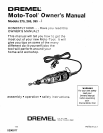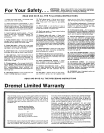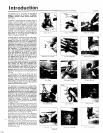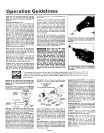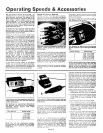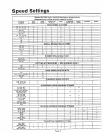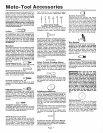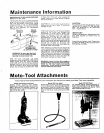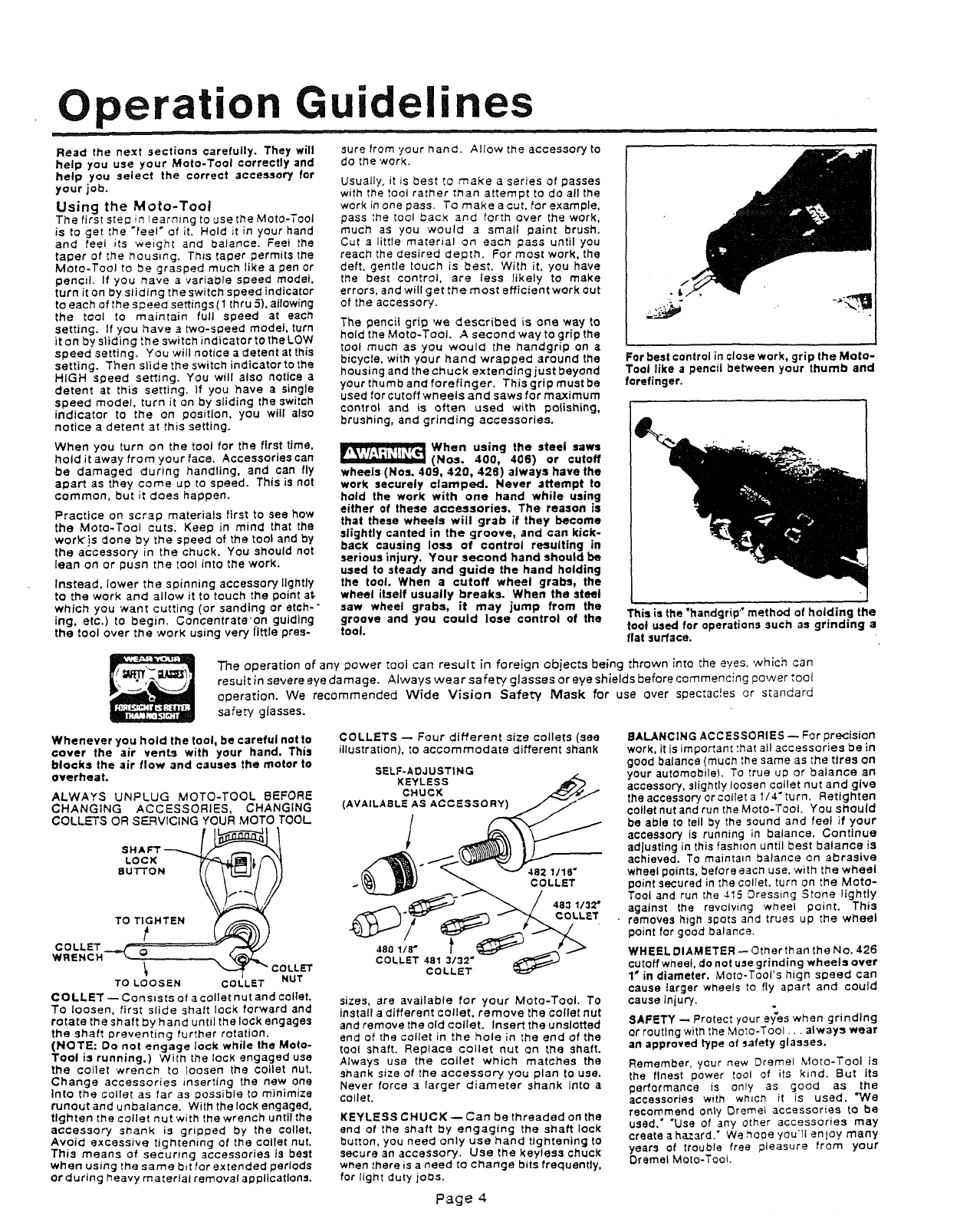
Operation Guidelines
Read the next sections carefully. They will
help you use your MolD-TOOl correctly and
help you select the correct accessory for
your job.
Using the Moto-Tool
The first step in learning to use the Moto-Tool
is to get the "feel" of it. Hold it in your hand
and feel its weight and balance. Feel the
taper of the housing. This taper permits the
Moto-Tool to be grasped much like a pen or
pencil. If you nave a variable speed model,
turn iron by sliding the switch speed indicator
to each of the speed settings (1 Ihru 5), allowing
the toot to maintain full speed at each
setting. If you have a two-speed model, turn
it on by sliding the switch indicator to the LOW
speed setting. You will notice a detent at this
setting. Then slide the switch indicatortothe
HIGH speed setting. You will also notice a
detent at this setting. If you have a single
speed model, turn it on by sliding the switch
indicator to the on position, you will also
notice a detent at this setting.
When you turn on the tool for the first time,
hold it away from your face. Accessories can
be damaged during handling, and can fly
apart as they come up to speed. This is not
common, but it does happen.
Practice on scrap materials first to see how
the Moto-Tool cuts. Keep in mind that the
work']s done by the speed of the tool and by
the accessory in the chuck. You should not
lean on or push the tool into the work.
Instead, lower the spinning accessory lightly
to the work and allow it to touch the point at.
which you want cutting (or sanding or etch-"
ing, etc.) to begin. Concentrate'on guiding
the tool over the work using very little pros-
sure from your hand. Allow the accessory to
do the work.
Usually, it is best to make a series of passes
with the tool rather than attempt to do all the
work in one pass. To make a cut. for example,
pass the tool bacX and forth over the work,
much as you would a small paint brush.
Cut a little material on each pass until you
reach the desired depth. For most work, the
deft, gentle touch is best. With it, you have
me best control, are less likely to make
errors, and will get the most efficient work out
of the accessory.
The pencil grip we described is one way to
hold the Moto-Tool. A second way to grip the
tool much as you would the handgrip on a
bicycle, with your hand wrapped around the
housing and the chuck extending just beyond
your thumb and forefinger. This grip must be
used for cutoff wheels and saws for maximum
control and is often used with polishing,
brushing, and grinding accessories.
When using the steel saws
(No.s. 400, 406) or cutoff
wheels (Nos. 409, 420, 426) always have the
work securely clamped. Never attempt to
hold the work with one hand while using
either of these accessories. The reason is
that these wheels will grab if they become
slightly canted in the groove, and can kick-
back causing loss of control resulting in
serious injury. Your second hand should be
used to steady and guide the hand holding
the tool. When a cutoff wheel grabs, the
wheel itself usually breaks. When the steel
saw wheel grabs, it may jump from the
groove and you could lose control of the
tool.
f,'
For best control in close work, grip the Moto-
Tool like a pencil between your thumb and
forefinger.
This isthe "handgrip" method of holding the
tool used for operations such as grinding a
flat surface.
The operation of any power tool can result in foreign objects being thrown into the eyes. ,which can
result in severe eye damage. Always wear safety glasses or eye shields before commencing oo,,ver tool
operation. We recommended Wide Vlsion Safety Mask for use over spectac!es or standard
safety glasses.
Whenever you hold the tool, be careful not to
cover the air vents with your hand. This
blocks the air flow and causes the motor to
overheat.
ALWAYS UNPLUG MOTO-TOOL BEFORE
CHANGING ACCESSORIES, CHANGING
COLLETS OR SF--=_VlCING YOUR MOTO TOOL
LOCK 77._IB)_ f_,l
BUT'tON
COLLET _
WRENCH o
l \ COLLET
TO LOOSEN COLLET NUT
COLLET -- Consists of a collet nut and toilet.
To loosen, first slide shaft lock forward and
rotate the shaft by hand until the lock engages
the shaft preventing further rotation.
(NOTE: Do not engage lock while the Moto-
Tool is running.) With the lock engaged use
the collet wrench to loosen the collet nut.
Change accessories inserting the new one
Into the collet as far as possible to minimize
runout and unbalance. With the lock engaged,
tighten the collet nut with the wrench until the
accessory shank is gripped by the poller.
Avoid excessive tightening of Ihe oollet nut.
This means of securing accessories is best
when using the same bit for extended periods
or during heavy material removal applications.
COLLETS -- Four different size toilets (see
illustration), to accommodate different shank
SELF-ADJUSTING
KEYLESS
CHUCK
AVAILABLE AS ACCESSORY)
/
482 1116"
COLLET
483 1132"
COLLET
sizes, are available for your Moto-Tool. To
install a different toilet, remove the cotlet nut
and remove the old collet. Insert the unslotted
end of the cotlet in the hole in the end of the
tool shaft. Replace collet nut on the shaft.
Always use the collet which matches the
shank size of the accessory you plan to use.
Never force a larger diameter shank into a
collet.
KEYLESS CHUCK--Can be threaded on the
end of the shaft by engaging the shaft lock
button, you need only use hand tightening to
secure an accessory. Use the keyless chuck
when there is a need to change bits frequently,
for light duty jobs.
BALANCING ACCESSORIES -- For precision
work, it is important that all accessories be in
good balance (much the same as the tires on
your automobile). To true up or balance an
accessory, slightly loosen collet nut and give
the accessory or collet a I/4" turn. Retighten
toilet nut and run the Moto-Toot. You should
be able to tell by the sound and feel if your
accessory is running in balance. Continue
adjusting in this fashion until best balance is
achieved. To maintain balance on abrasive
wheel points, before each use, with the wheel
point secured in me toilet, turn on the Moto-
Tool and run the 415 Dressing Stone lightly
against the revolving wheel point. This
removes high soots and trues up the wheel
point for good balance.
WHEEL DIAMETER -- Other than the No. 426
cutoff wheel, do not use grinding wheels over
1" in diameter, Mote-Tool's high speed can
cause larger wheels to fly apart and could
cause injury.
SAFETY -- Protect your ey_es when grinding
or routing with the Moto-Tool... always wear
an approved type of safety glasses.
Remember. your new Dremel Moto-Tool is
the finest power tool of its kind. But its
performance is only as good as the
accessories with wmct_ it is used. "_'e
recommend onb/ Oreme{ accessories to be
used," "Use of any other accessories may
create a hazard." We hope you'll enjoy many
years of trouble free pleasure from your
Oremel Moto-Tool.
Page 4



